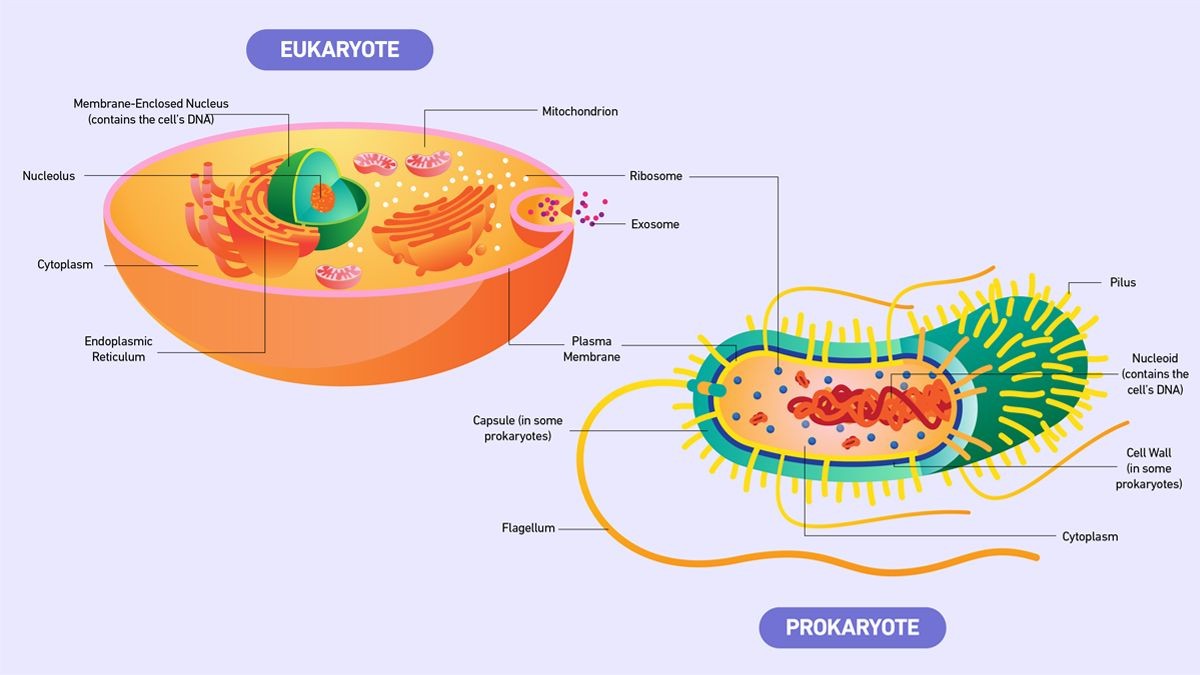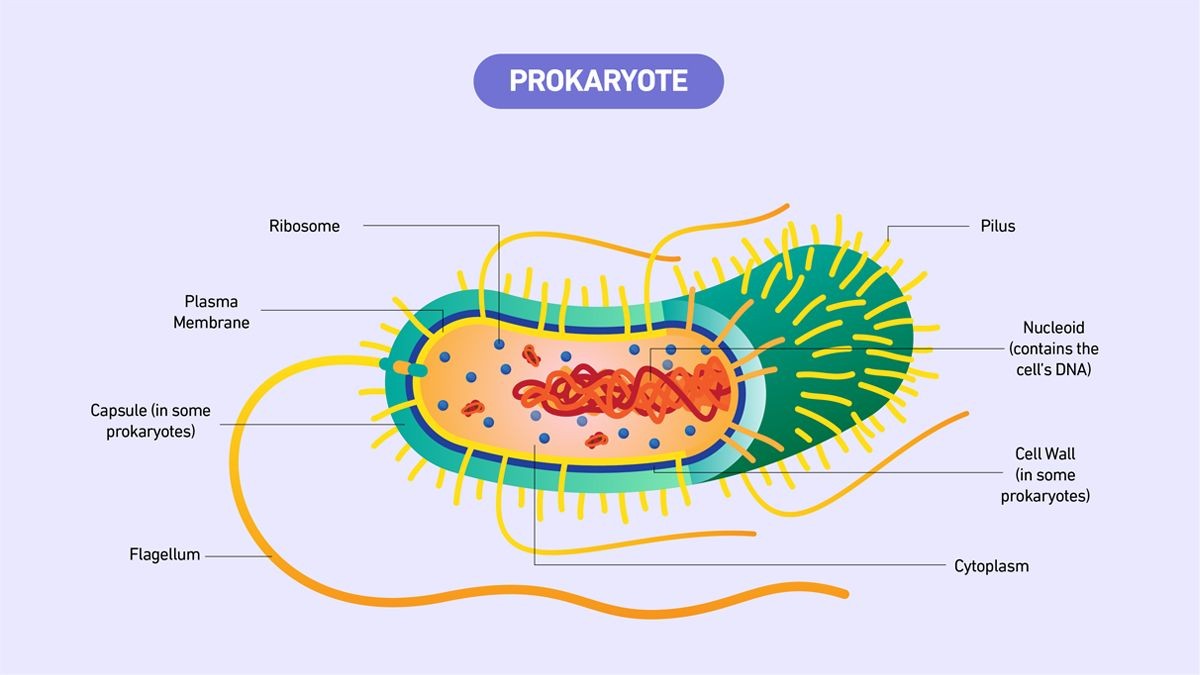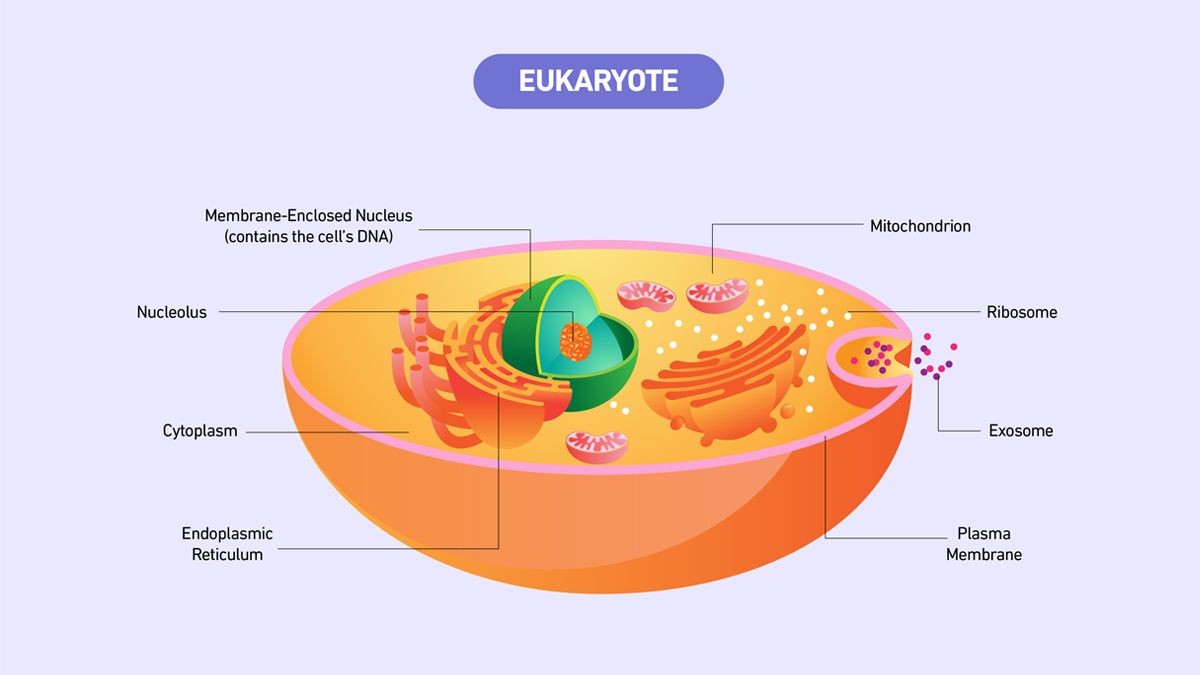Understanding the difference between prokaryotic and eukaryotic cells is fundamental to biology. At WHAT.EDU.VN, we simplify complex topics and offer clear answers. Prokaryotic cells lack a nucleus and membrane-bound organelles, while eukaryotic cells possess these features. This article explores these key distinctions, covering cell structure, DNA organization, and examples of each cell type, ensuring you grasp the core concepts of cell biology. For further exploration, consider investigating cellular biology and cell structure.
1. Comparing Prokaryotes And Eukaryotes
Prokaryotes are believed to be the earliest life form. Scientists estimate that eukaryotes evolved from prokaryotes approximately 2.7 billion years ago.
The widely accepted theory regarding the origin of eukaryotes suggests that two prokaryotes formed a symbiotic relationship and merged through a process called endosymbiosis. It is believed that endosymbiotic events led to the development of membrane-bound organelles such as mitochondria. Thanks to mitochondria, eukaryotic ancestors had sufficient energy to develop into the more complex eukaryotic cells known today.
However, research from the University of Jena, published in the journal mBio, has shown that prokaryotic bacteria can “eat” other cells. This contradicts previous beliefs that only eukaryotes could perform endocytosis (a cellular process in which substances are brought into the cell and form intracellular vesicles). These more recent findings suggest the need to re-evaluate theories regarding the origin of eukaryotes.
The primary distinction between these two types of organisms is that eukaryotic cells have a membrane-bound nucleus, and prokaryotic cells do not. The nucleus is where eukaryotes store their genetic information. In prokaryotes, DNA is bundled together in the nucleoid region, but it is not stored within a membrane-bound nucleus.
The nucleus is only one of many membrane-bound organelles in eukaryotes. Prokaryotes, on the other hand, have no membrane-bound organelles. Another important difference is the DNA structure and location. Eukaryote DNA consists of multiple molecules of double-stranded linear DNA found in the nucleus, while that of prokaryotes is double-stranded, often circular, and located within the cytoplasm. However, it is worth noting that linear plasmids and chromosomes have been found in certain prokaryotes.
2. Key Similarities Between Prokaryotes And Eukaryotes
All cells, whether prokaryotic or eukaryotic, share these four features:
- DNA
- Plasma membrane
- Cytoplasm
- Ribosomes
3. What Are The Key Differences Between Prokaryotes And Eukaryotes?
Prokaryotes and eukaryotes vary in several important ways – these differences include structural variation – whether a nucleus is present or absent and whether the cell has membrane-bound organelles. The differences are summarized in Table 1, below.
Table 1: Differences between prokaryotes and eukaryotes.
| Prokaryote | Eukaryote | |
|---|---|---|
| Nucleus | Absent | Present |
| Membrane-bound organelles | Absent | Present |
| Cell structure | Unicellular | Mostly multicellular; some unicellular |
| Cell size | Typically smaller (0.1–5 μm), however, a much larger (centimeter-long) bacterium has recently been discovered in a mangrove swamp. | Larger (10–100 μm) |
| Complexity | Simpler | More complex |
| DNA Form | Often circular, however, linear plasmids and chromosomes have been found in certain prokaryotes. | Linear |
| Examples | Bacteria, archaea | Animals, plants, fungi, protists |



3.1. Transcription And Translation In Prokaryotes Vs Eukaryotes
In prokaryotic cells, transcription and translation are coupled, meaning translation begins during mRNA synthesis.
In eukaryotic cells, transcription and translation are not coupled. Transcription occurs in the nucleus, producing mRNA. The mRNA then exits the nucleus, and translation occurs in the cell’s cytoplasm.
4. Prokaryote Definition
Prokaryotes can be split into two domains, bacteria and archaea, and are unicellular organisms that lack membrane-bound structures. Prokaryotic cells tend to be small, simple cells, measuring around 0.1–5 μm in diameter.
While prokaryotic cells do not have membrane-bound structures, they do have distinct cellular regions. In prokaryotic cells, DNA bundles together in a region called the nucleoid. In prokaryotes, molecules of protein, DNA and metabolites are all found together, floating in the cytoplasm. Primitive organelles, found in bacteria, do act as micro-compartments to bring some sense of organization to the arrangement.
4.1. Prokaryotic Cell Features
Here is a breakdown of what you might find in a prokaryotic bacterial cell.
- Nucleoid: A central region of the cell that contains its DNA.
- Ribosome: Ribosomes are responsible for protein synthesis.
- Cell wall: The cell wall provides structure and protection from the outside environment. Most bacteria that include this have a rigid cell wall made from carbohydrates and proteins called peptidoglycans.
- Cell membrane: Every prokaryote has a cell membrane, also known as the plasma membrane, that separates the cell from the outside environment.
- Capsule: Some bacteria have a layer of carbohydrates that surrounds the cell wall called the capsule. The capsule helps the bacterium attach to surfaces and protects it from harmful substances or conditions.
- Pili: Pili, also referred to as fimbriae, are rod-shaped structures involved in multiple roles, including attachment and DNA transfer.
- Flagella: Flagella are thin, tail-like structures that assist in movement.
4.2. Examples Of Prokaryotes
Bacteria and archaea are the two types of prokaryotes.
4.3. Do Prokaryotes Have A Nucleus?
Prokaryotes do not have a nucleus. Instead, prokaryote DNA can be found, bundled but free-floating, in a central region called the nucleoid. Prokaryote DNA is usually found as a single chromosome of circular DNA. These organisms also lack other membrane-bound structures such as the endoplasmic reticulum.
4.4. Do Prokaryotes Have Mitochondria?
No, prokaryotes do not have mitochondria. Mitochondria are only found in eukaryotic cells. This is also true of other membrane-bound structures like the nucleus and the Golgi apparatus.
5. Eukaryote Definition
Eukaryotes are organisms whose cells have a nucleus and other organelles enclosed by a plasma membrane. Organelles are internal structures responsible for a variety of functions, such as energy production and protein synthesis.
Eukaryotic cells are large (around 10–100 μm) and complex. While most eukaryotes are multicellular organisms, there are some single-cell eukaryotes.
5.1. Eukaryotic Cell Features
Within a eukaryotic cell, each membrane-bound structure carries out specific cellular functions. Here is an overview of many of the primary components of eukaryotic cells.
- Nucleus: The nucleus stores the genetic information in chromatin form.
- Nucleolus: Found inside of the nucleus, the nucleolus is the part of eukaryotic cells where ribosomal RNA is produced.
- Plasma membrane: The plasma membrane is a phospholipid bilayer that surrounds the entire cell and encompasses the organelles within.
- Cytoskeleton: The system of protein fibers and other molecules that gives shape to the cell, aiding in the correct positioning of organelles.
- Cell wall: The cell wall is only found in certain eukaryotes, such as plant cells, and is a rigid covering that provides structural support and protection to the cell.
- Ribosomes: Ribosomes are responsible for protein synthesis.
- Mitochondria: Mitochondria, also known as the powerhouses of the cell, are responsible for energy production.
- Cytoplasmic space: The cytoplasmic space is the region of the cell between the nuclear envelope and plasma membrane.
- Cytoplasm: The cytoplasm is defined as the total inner-cellular volume, with the exception of the nucleus, and includes the cytosol and all organelles.
- Cytosol: The cytosol, which consists of a gel-like substance, accounts for all the material in the cytoplasm, excluding the contents of the various membrane-bound organelles.
- Endoplasmic reticulum: The endoplasmic reticulum is an organelle dedicated to protein maturation and transportation.
- Vesicles and vacuoles: Vesicles and vacuoles are membrane-bound sacs involved in transportation and storage.
Other common organelles found in many, but not all, eukaryotes include the Golgi apparatus, chloroplasts and lysosomes.
5.2. Examples Of Eukaryotes
Animals, plants, fungi, algae and protozoans are all eukaryotes.
FAQ: Prokaryotic vs Eukaryotic Cells
1. What is the primary function of a nucleus in a eukaryotic cell?
The nucleus stores the cell’s genetic information in the form of DNA, organized into chromatin. It controls cell growth, metabolism, and reproduction. According to research from Harvard University, the nucleus protects DNA from damage and regulates gene expression.
2. How do prokaryotic cells replicate?
Prokaryotic cells primarily replicate through binary fission, a process where the cell divides into two identical daughter cells after DNA replication. Stanford University research indicates this method is efficient for rapid reproduction in stable environments.
3. What role do ribosomes play in both prokaryotic and eukaryotic cells?
Ribosomes synthesize proteins by translating mRNA into amino acid chains. Yale University studies have shown that while the function is the same, eukaryotic ribosomes are larger and more complex than prokaryotic ribosomes.
4. Why are mitochondria often referred to as the “powerhouses” of eukaryotic cells?
Mitochondria generate most of the cell’s ATP (energy) through cellular respiration. Research from MIT highlights their critical role in energy production and regulation of cellular metabolism.
5. What is the significance of the cell wall in prokaryotic cells?
The cell wall provides structural support and protection against external stresses. According to a study by the University of California, Berkeley, the composition and structure of the cell wall vary between different species of bacteria and archaea.
6. How do vesicles and vacuoles contribute to the function of eukaryotic cells?
Vesicles and vacuoles are membrane-bound sacs that transport and store various substances within the cell. Research from Johns Hopkins University demonstrates their involvement in processes like exocytosis, endocytosis, and waste management.
7. What are the main differences in DNA structure between prokaryotes and eukaryotes?
Eukaryotic DNA is linear and organized into multiple chromosomes within the nucleus, while prokaryotic DNA is typically circular and located in the nucleoid region. A study from the University of Michigan emphasizes that eukaryotes have more complex DNA packaging and regulatory mechanisms.
8. How does the presence or absence of membrane-bound organelles affect the complexity of cellular processes?
The presence of membrane-bound organelles in eukaryotic cells allows for compartmentalization, which enhances the efficiency and regulation of cellular processes. Research from the University of Oxford suggests that this compartmentalization enables eukaryotes to perform more complex functions than prokaryotes.
9. In what ways are bacteria and archaea similar, and how do they differ?
Both bacteria and archaea are prokaryotic cells and share basic cellular structures, but they differ in their genetic makeup and biochemistry. According to research from the University of Tokyo, archaea have unique lipids in their cell membranes and distinct metabolic pathways.
10. What are the implications of coupled transcription and translation in prokaryotic cells?
Coupled transcription and translation enable rapid protein synthesis, allowing prokaryotes to quickly respond to environmental changes. A study by the Max Planck Institute indicates this efficiency is crucial for their survival in fluctuating conditions.
Do you still have questions about cell biology, prokaryotes, or eukaryotes? Don’t hesitate to ask your question for free at WHAT.EDU.VN. Our team of experts is here to provide clear and concise answers to all your academic inquiries. Contact us at 888 Question City Plaza, Seattle, WA 98101, United States, or via WhatsApp at +1 (206) 555-7890. Visit our website at what.edu.vn and get the answers you need today.
